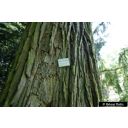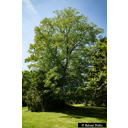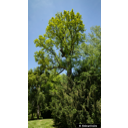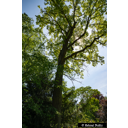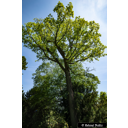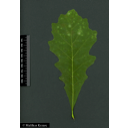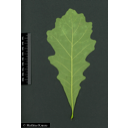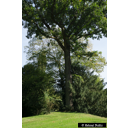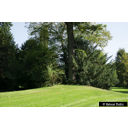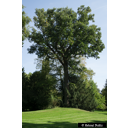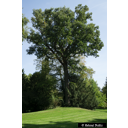Useful information about the taxon (species, subspecies, variety...)
Quercus macrocarpa Michx. 1801
Fagaceae
(APG IV)bur oak, mossycup oak
Taxon concept: The Plant List (2014), version 1.1
Distribution: southeastern and south-central Canada; northeastern, southeastern, south-central, north-central United States (Great Plains)
Quercus macrocarpa Michx. - Accepted: Quercus macrocarpa Michx. bei The Plant List (2010); Familie: Fagaceae (APG III)Quercus macrocarpa Michx. - Accepted: Quercus macrocarpa Michx. bei The Plant List (2014), version 1.1; Familie: Fagaceae (APG III)
- Flowers
- monoecious
- Flower ecology
- wind-pollinated (anemophilous)
- Life form
- tree
- Foliage persistence
- deciduous
- Fruits
- acorns are the largest ones compared to any other North American oaks
- Fruit ecology
- animal-dispersed (zoochorous) (by rodents and blue jays)
- Root type
- long taproot
- Natural occurrence (habitat)
- oak savannas, prairies, woodlands, oak-hickory forests
- Vegetation typ and synecology (plant community)
- temperate, mesophytic broad-leaved and mixed forests and temperate grasslands, savannas, and shrublands
- Life span
- long-lived tree (300 to 400 years old)
- Usage
- ornamental tree (park tree); wood is industrially used for railroad ties, cabinetry and tight cooperage as well as for hardwood flooring and fence posts; the bark has been used as a mordant for fixing dyes
- Bark
- medium grey and rugged bark
Erhardt, W., Götz, E., Bödeker, N. & Seybold, S. (2008): Der große Zander. Enzyklopädie der Pflanzennamen. Band 2. Arten und Sorten. Eugen Ulmer KG, Stuttgart (Hohenheim), 18. Aufl., 2103 S.; The International Plant Names Index (2009). Published on the Internet http://www.ipni.org; Courtesy to IPNI, 2009. Exported from IPNI at date: 2009-09-22 20:17:51; Zamudia, S. R. & Studnicka, M. (2000): Nueva especie gipsícola de Pinguicula (Lentibulariaceae) del estado de Oaxaca, México. Acta. Bot. Mex. 53., 67-74;
Diese Webseite verwendet Google Maps, um Karten und Standorte von Pflanzen in den Hohenheimer Gärten anzuzeigen. Dadurch werden unter Umständen Daten an Google weitergeleitet, was mit einer Verarbeitung Ihrer personenbezogenen Daten verbunden sein kann. Die Datenschutzerklärung von Google finden Sie hier: Datenschutzerklärung von Google
| Sex | Standort | Accession number | Planting year | Donation | IPEN | Lat. | Long. |
|---|---|---|---|---|---|---|---|
| Klimabäume Hohenheim West | KLB-071-20451 | XX-0-HOH-KLB-071-20451 | 0 | 0 | |||
| Klimabäume Hohenheim West | KLB-073-20451 | XX-0-HOH-KLB-073-20451 | 0 | 0 | |||
| Klimabäume Hohenheim West | KLB-074-20451 | XX-0-HOH-KLB-074-20451 | 0 | 0 | |||
| Parzelle C | EG-C-031-17817 | 1799 | XX-0-HOH-EG-C-031-17817 | 48,7098937657 | 9,2059769092 | ||
| Parzelle T | LG-T-034-17819 | 1998 | + | XX-0-HOH-LG-T-034-17819 | 48,7064026836 | 9,2121040095 | |
| Parzelle U | LG-U-026-17818 | 1998 | + | XX-0-HOH-LG-U-026-17818 | 48,7063752189 | 9,212480711 | |
| Parzelle E | SP-EB-039-2971 | 2019 | XX-0-HOH-SP-EB-039-2971 | 48,7109769865 | 9,2119544191 | ||
| Parzelle E | SP-EB-062-17808 | 2017 | XX-0-HOH-SP-EB-062-17808 | 48,7108828307 | 9,2119031231 | ||
| Parzelle E | SP-EB-032-20451 | 2012-11 | XX-0-HOH-SP-EB-032-20451 | 48,71103607 | 9,211881 |

